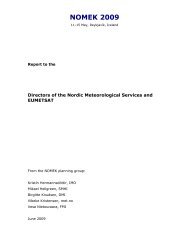International Symposium on Mitigative Measures against Snow ...
International Symposium on Mitigative Measures against Snow ...
International Symposium on Mitigative Measures against Snow ...
You also want an ePaper? Increase the reach of your titles
YUMPU automatically turns print PDFs into web optimized ePapers that Google loves.
<str<strong>on</strong>g>Internati<strong>on</strong>al</str<strong>on</strong>g> <str<strong>on</strong>g>Symposium</str<strong>on</strong>g> <strong>on</strong> <strong>Mitigative</strong> <strong>Measures</strong> <strong>against</strong> <strong>Snow</strong> Avalanches<br />
Egilsstaðir, Iceland, March 11–14, 2008<br />
After some initial reliability problems were resolved, the SM4 was able to measure the snow<br />
depth with acceptable accuracy for avalanche forecasting. From the data, it is easy to<br />
distinguish the sensors buried in snow from the <strong>on</strong>es above the snow surface. Figure 2 shows<br />
data from all the sensors of a SM4 unit. The graph shows very little fluctati<strong>on</strong>s for the sensors<br />
buried in snow, while the sensors above the snow surface display greater fluctati<strong>on</strong> in<br />
temperature. The blue line shows an example of a thermistor that is above the surface in the<br />
beginning of the period, but becomes covered by snow <strong>on</strong> March 6 th . Figure 4 shows the<br />
temperature profile from an SM4 sensor located in Kistufell by Ísafjörður. The snow depth is<br />
at the upper brake of the gradient. During this period, the snow depth increased from 180 cm<br />
to 250 cm.<br />
Figure 4. Temperature profiles measured by SM4 with five days interval.<br />
An algorithm that calculates the snow depth from a time-series of temperature profiles<br />
through the snowpack has been developed, and gives promising results. Figure 3 shows the<br />
calculated snow depth and compares it with snow depth data from the ultras<strong>on</strong>ic sensor. (Note<br />
that the timespan is the same as for Figure 2.) The gap in the data from the ultras<strong>on</strong>ic sensor is<br />
c<strong>on</strong>sidered to be due to icing. The challenge regarding the algorithm is greatest when the<br />
temperature of the atmosphere approaches the temperature of the snowpack.<br />
For IMO it is of special interest to test the reliability of SM4 during icing periods since the<br />
ultras<strong>on</strong>ic sensors do not work well under those circumstances. The following picture (Figure<br />
5) was taken <strong>on</strong> December 9 th and shows the instruments with an icing coat. The ultras<strong>on</strong>ic<br />
sensor had not been working in the days before, and it is c<strong>on</strong>sidered very likely that the reas<strong>on</strong><br />
was icing. The data from SM4 seems correct from those same days (Figure 6), and therefore,<br />
it can be c<strong>on</strong>cluded that icing in this magnitude does not interfere with the air temperature<br />
measurements of SM4.<br />
154 The SM4 snowpack temperature and snow depth sensor











